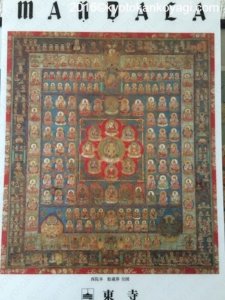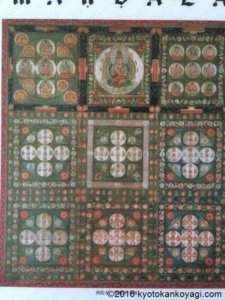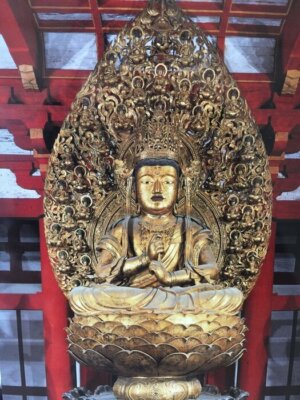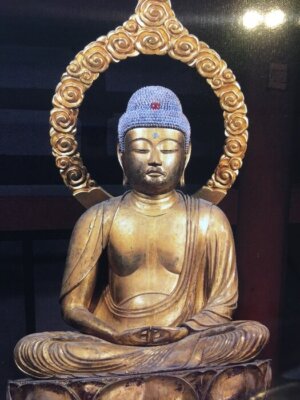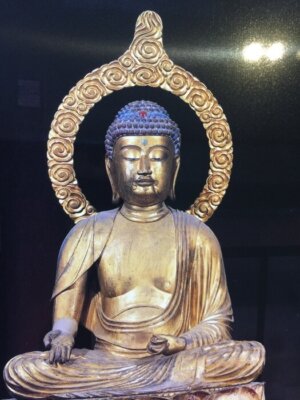Introduction
What is Mandala? 曼荼羅とは?
Mandala is a picture. Its configurations of images and letters show us the teaching of Vajrayana Buddhism.
The word “Mandala” divided into two words; “Manda” and “la.”
“Manda” means “Essence” and “la” means “to have.”
So, Mandara stands for “The thing which has the essence ( of Vajrayana Buddhism).”
There are many kind of Mandala in this world.
In Japan, in terms of metaphor, we have three kinds of Mandala; Dai-Mandala, Hoh-Mandala, and Sanya-Mandala.
Kukai, the founder of Shingon Buddhism and one of the most famous monk in Japan, brought all of them to Japan from China in the 9th century.
On the other hand, in terms of structure, we also have three kinds of Mandala; Picuture-Mandala, Sand-Mandala, and 3D-Mandala.
Classification of Mandala in terms of metaphor
Dai-Mandala 大曼荼羅
Dai-Mandala is the most popular Mandala in Japan. It has many images of Deities.
Hoh-Mandala 法曼荼羅
Hoh-Mandala doesn’t have images. It has Siddham scripts instead.
Sanmaya-Mandala 三昧耶曼荼羅
Sanmaya-Mandala doesn’t have images nor scripts. It has Mudora instead. Mudora is a Sanskrit word. It tells us what each Deity is. In Japanese, it is translated as “Inso.” The word means a gesture of hand(s) or things which a Deity has.
For example, the statue of Amida-Nyorai in Byodo-in temple has a gesture called Joh-in which stands for Amida-Nyorai in a Mandala of Vajrayana Buddhism.
On the other hand, Fudoh-Myo-Oh has a sword. It stands for Fudoh-Myo-Oh in Mandala.
Ryokai-Mandala 両界曼荼羅
What is Ryokai-Mandala 両界曼荼羅の構成
These three Mandala have Ryokai-Mandala each other. “Ryokai” means “two worlds.” Ryokai-Mandala consists of Taizokai-Mandala and Kongokai-Mandala. Both of them have images/scripts/Mudora of Vairocana, the prime Deity in Vajrayana Buddhism. Vairocana in Taizokai-Mandala means the truth in Buddhism and that of Kongokai Mandala does the wisdom lead us to the truth.
Taisokai-Mandala 胎蔵界曼荼羅
Taizokai-Mandala represents The Mahavairocana Tantra, the most important text in Vajrayana Buddhism. It shows us the way the truth of Buddhism spreads all over the world. It has 415 images/scripts/Mudora of Deities.
金剛界曼荼羅
Kongokai-Mandala representsThe Vajrasekhara Sutra, an important text in Vajrayana Buddhism. It shows us the way the wisdom leads us to the truth of Buddhism. It has 1462 images/scripts/Mudora of Deities.
Classification of Mandala in terms of structure
Picture-Mandala
Picture-Mandala is a Mandala painted on paper, cloth, and so on.
Sand-Mandala
San-Mandala is constructed on Sand.
3D-Mandala/Katsuma-Mandala 立体曼荼羅/羯磨曼荼羅
3D-Mandala/Katsuma-Mandala consists of statues of Deities. Toji temple has this kind of Mandala. It has twenty one statues and divided into four parts; Nyorai-bu, Bosatsu-bu, Myo-oh-bu, and Ten-bu.
The Mandala was constructed in the 9th century and caught by fire in 1486 and some of them are burnt out.
The 3D-Mandala is located in Kodo-hall in Toji temple. The hall had not been open to public for nearly a thousand year. In 1965, it opened the door to us for the first time in its history.
The 3D-Mandala of Toji temple 東寺立体曼荼羅
Nyorai-bu 五智如来像(如来部)
Introduction
It consists of statues of Dainichi-Nyorai, Amida-Nyorai, Hojo-Nyorai, Fuku-Joju-Nyorai, and Ashuku-Nyorai.
These Deities called “Nyorai” in Japanese. The word means the truth of Buddhism. They reached the truth and have no need to dress themselves up. So, they wear only sheets of cloth.
Dainich-Nyorai 大日如来像(center)
In Vajrayana Buddhism, Vairocana represents the truth or the whole universe. It has Inso gesture called “Chikenin.” It tells us that the statue stands for a Vairocana of Kongokai-Mandala.
Amida-Nyorai 阿弥陀如来像(front, left)
Amitabha means eternal life or limitless light in Sanskrit. It rules the eastern paradise in Buddhism. If we confess “Namu Amidabutsu (I believe in Amitabha),” it leads us to the paradise.
Hojo-Nyorai 宝生如来像(front, right)
Ratnasambhava means that the one born of treasure. In “Byodo Shochi,” it treats anyone and anything equal.
Fuku-Joju-Nyorai 不空成就如来像(back, left)
Amoghasiddhi is in the fulfilled state of mind called “Joso Sachi.”
Asuku-Nyorai 阿閦如来像(back, right)
Akshobhya is equal to the pure and clear mind of Dainichi-Nyorai.


